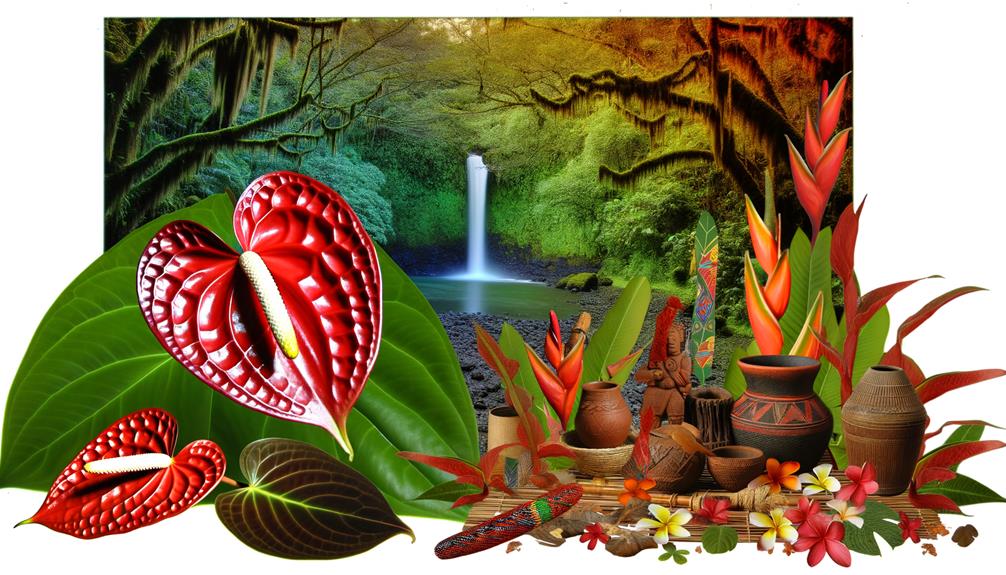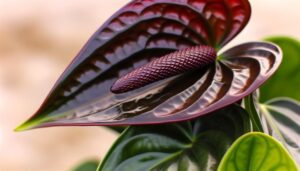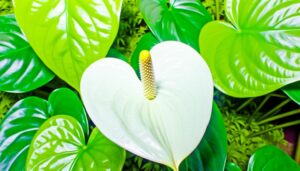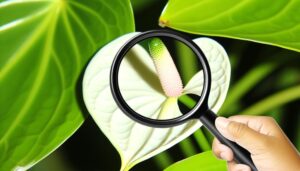Discover the Hawaiian Name for Anthurium – A Cultural Guide
You'll find that the Hawaiian name for anthurium is 'kāpili,' signifying union and harmony. Pronounced 'kah-PEE-lee,' this name reflects the plant's symbolic role in Hawaiian culture, embodying love and connection.
Anthuriums, with their heart-shaped spathes, are integral in lei-making and are seen as representations of hospitality and aloha. They're also featured in Hawaiian legends and myths, attributed with protective and emotive qualities.
Understanding the cultural significance and care techniques for anthuriums in Hawaii enhances your appreciation of this beautiful plant and its role in local traditions. Keep going to uncover more about its fascinating cultural context.

Key Takeaways
- The Hawaiian name for anthurium is 'kāpili,' meaning union and harmony.
- Pronounced as 'kah-PEE-lee,' the name reflects the plant's symbolic ability to bring people together.
- Anthuriums are used in leis to symbolize hospitality, love, and friendship in Hawaiian culture.
- The plant's heart-shaped spathes mirror Hawaiian values of love and affection.
- Understanding the name 'kāpili' offers deeper appreciation of anthurium's cultural significance in Hawaii.
The Significance of Anthurium
Known for its striking appearance and vibrant color, the anthurium holds significant cultural and ecological importance in Hawaiian traditions and natural ecosystems. You'll find that this flower isn't just beautiful; it's a symbol deeply woven into the fabric of Hawaiian life.
Traditionally, anthuriums are used in lei-making, representing hospitality and aloha. Their heart-shaped spathes reflect the Hawaiian value of love and affection.
Ecologically, anthuriums thrive in Hawaii's humid climate, playing a role in local biodiversity. They provide shelter and nourishment to various insects and birds. Understanding the anthurium's role helps you appreciate its significance beyond mere aesthetics, embracing both its cultural symbolism and ecological contributions.
It's not just a flower—it's an essential part of Hawaii's identity.
Hawaiian Name and Pronunciation
The Hawaiian name for anthurium, 'kāpili,' reflects its integral role in Hawaiian culture and language, emphasizing its connection to the concepts of union and harmony. Pronounced kah-PEE-lee, this name is rich in meaning, rooted in the word 'pili,' which signifies to cling or join.
In Hawaiian tradition, names aren't just labels; they're deeply symbolic, embodying the essence of the object they describe. When you say 'kāpili,' you're invoking the plant's ability to bring people and elements together, mirroring its vibrant, heart-shaped spathes that naturally draw attention and admiration.
Understanding the pronunciation and linguistic roots of 'kāpili' offers you a deeper appreciation for the anthurium's esteemed place in Hawaiian culture.
Cultural Symbolism and Uses
Anthuriums, with their vibrant colors and heart-shaped spathes, serve as powerful symbols of hospitality, love, and friendship in Hawaiian culture. When you give an anthurium, you're extending an invitation of warmth and welcome.
Traditionally, these flowers are used in leis, which are given to honor guests and loved ones. Their striking appearance makes them perfect for festive decorations, embodying the Aloha spirit.
Beyond aesthetics, anthuriums possess practical uses; their sturdy stems are sometimes incorporated into traditional weaving. In local ceremonies, they're often placed on altars as offerings.
Understanding these cultural nuances deepens your appreciation of the anthurium's multifaceted role in Hawaiian life, blending beauty with profound symbolic meaning.
Legends and Myths
While anthuriums hold significant cultural symbolism, they're also woven into Hawaiian legends and myths that add layers of meaning to their already rich heritage.
One popular legend involves the goddess Pele, the deity of volcanoes and fire. According to the myth, Pele's intense emotions are mirrored in the anthurium's vibrant red color, symbolizing both passion and wrath.
Another tale speaks to the plant's resilience. Warriors believed that carrying anthurium petals would protect them in battle, imbuing them with strength and courage. This belief is rooted in the plant's heart-shaped spathes, which represent endurance and love.
These stories not only elevate the plant's status but also deepen your understanding of its cultural importance in Hawaii.
Caring for Anthurium in Hawaii
Caring for anthurium in Hawaii requires understanding the island's unique climate and utilizing traditional horticultural practices to guarantee the plant thrives. Hawaii's tropical conditions—high humidity, moderate temperatures, and frequent rainfall—mimic the anthurium's natural habitat.
You'll need to ensure well-draining soil, rich in organic matter, to avoid root rot, a common issue in this climate. Place your anthurium in a spot with filtered sunlight to replicate the dappled light of the rainforest canopy.
Water consistently but don't let the roots sit in water. Incorporate traditional Hawaiian mulch, like shredded ti leaves or coconut husk, to retain moisture and nutrients. By blending scientific knowledge with cultural wisdom, you can cultivate a flourishing anthurium that honors its Hawaiian roots.
Conclusion
In Hawaii, the anthurium, known as 'nā kāhili,' carries rich cultural symbolism and unique legends.
You've explored its significance, pronunciation, and usage, delving into the heart of Hawaiian tradition.
Remember, 'knowledge is power.'
By understanding how to care for nā kāhili, you honor both the plant and its storied heritage.
Embrace this blend of scientific accuracy and cultural depth to keep these vibrant symbols thriving in your own Hawaiian paradise.






